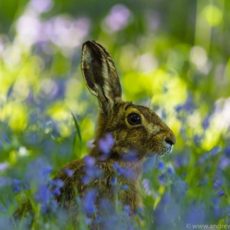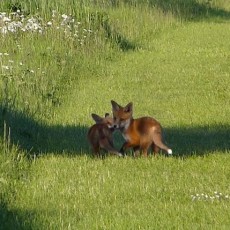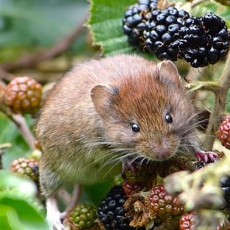I had a gut feeling that I would see otters before setting out that morning into the otherworldly mist before dawn. But my head often questions whether my heart is right, so I wasn’t sure. About fifteen minutes after arriving at the lake, I saw an otter’s head emerge from its waters in a nearby bay. It was clearly a female by the size of the head. She was looking directly at me, the beauty of her vibrissae (whiskers) which she uses to sense prey underwater were glistening. We stared at each other in disbelief! But I was pin-drop quiet and still, so she continued to fish beneath the tangled roots of the over-hanging willows, occasionally disappearing from view. It was a joy to watch such a graceful member of my local community searching for her supper at first light. A veritable water sprite.
The otter then headed towards an island and disappeared. During her absence, I briefly saw another otter with a much smaller cub heading towards another island. She must have left the lake to feed the cub and remained there. The blog listing image is a video frame shot by Stephen de Vere at another location, but it is about the same size as the smaller cub that I saw.
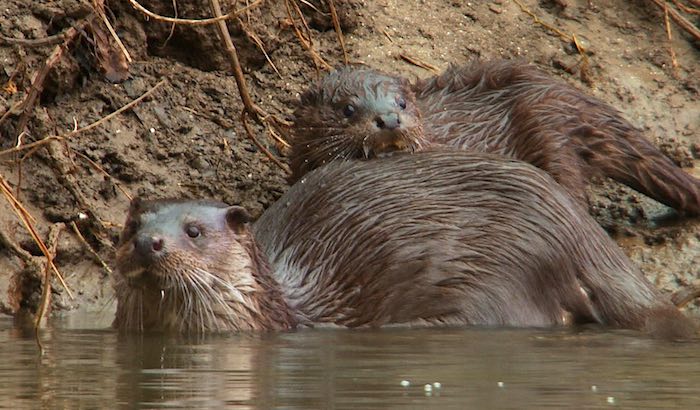
Shortly after this, the first otter re-appeared having collected her two cubs, who were not yet full grown. I was amazed at her trust in me, so much so that she casually sprainted on a branch before romping off with her cubs who had run ahead of her.
They then swam underneath the island’s overhanging trees, spooking a coot. Swimming with an agility and fluidity, almost as one body, sensing each other’s intentions, they searched amongst roots protruding into the lake before completely disappearing from sight in this beautiful wetland ecosystem. You can hear a kingfisher’s piping call in the background. It is thanks to working recently as a field assistant on the wildlife documentary film Return to the River that I was able to track the movement of the otters with ease by following their wakes when they disappeared underwater, or by watching their bubble streams when they were close to the shoreline.
This lake is ideal otter habitat, offering food and shelter on undisturbed, densely vegetated island sanctuaries, some with impenetrable bramble. To see an otter and her two cubs was beyond my wildest dreams. I am so lucky to live near to a lake with an abundance of beautiful biodiversity. This morning’s rendezvous was an unexpected surprise, as it was my third otter encounter in a month. So my heart was right and my head was wrong! On the second occasion, I had watched these otters for a glorious twenty minutes on another misty dawn which occasionally made it difficult to see them when the mist became dense. I returned home walking on air again, but even more so because my local community and I spent three years of gentle but determined campaigning to save this lake and an adjoining smaller one. This joyful encounter made every moment spent worth it. Unfortunately, fishermen have fenced off the smaller lake, bereft of compassion for the otters and water voles who share these wetlands. The reason why this is totally unnecessary will become clear as you read on.
Why aren’t otters to blame for fish decline in our rivers?
The Eurasian otter (Lutra lutra) is native to the UK. Otters will use all wetland habitats, including rivers, streams, lakes and ponds, but also ditches, marshes, reedbeds, swamps and wet woodland alongside watercourses. They also live in coastal regions. They are usually nocturnal and require dense cover for lying-up during the day, or during breeding, and will use tree root cavities, river bank burrows, scrub and tall vegetation along watersides.
The size of an otter’s territory naturally depends on the availability of food and shelter and the presence of neighbouring otters. They recolonised the British Isles after the last Ice Age and were widespread in all of our wetland ecosystems during much of the intervening 10,000 years. Which begs the question: how did fish manage to survive at all when there were so many otters? Also, why are Alaskan rivers still teeming with fish and yet they are taken by otters and bears? The myth that otters are responsible for the decline of fish in Britain is beginning to unravel.
There was a time when rivers across the UK (including the River Thames) were abundant with otters, salmon, and eels, just like Alaska’s. There were so many eels that our rivers were said to ‘heave with them’ at times and a local person where I live recalls their uncle catching ‘bucket loads’ on a local river within living memory. Yet almost none exist here now.
Most of the otters diet is fish (usually 75-95%) although amphibians, crayfish (notably the non native American signal crayfish), small mammals and waterfowl will also be taken. Ducks and coots are well aware of this, so you will see them constantly taking flight when otters are around (or keeping out of the water) to avoid them. Usually, the fish they take are less than 300mm in length. They may seasonally move to upland marshes and headwaters to hunt for prey such as spawning frogs and may follow runs of salmon or sea-trout upstream. Where eels are still found, they are the only prey that wildlife filmmaker Stephen de Vere has seen otters really fight over and has filmed this behaviour. They really are an otter’s favourite food.
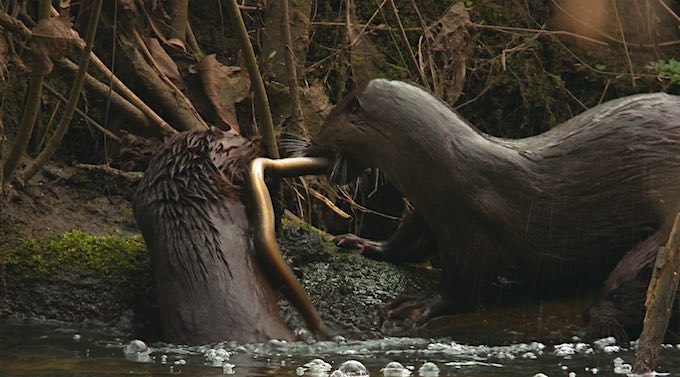
Although very large fish may be taken, the otter’s diet varies according to the time of year and place and depends on what species are generally available in the environment around them. But they are opportunists and so will take what is easiest to catch (very much like us) – hence their liking garden ponds and stocked fishing lakes. Although, unlike humans, who have infamously overfished their oceans, otters take prey in proportion to their local and seasonal availability. We could learn a thing or two about sustainable fishing from our mammalian brothers!
Why have we lost fish stocks in our rivers?
I often question a fisherman’s need to catch fish as a sport, unless it is due to living a life closer to nature with a real need to sustain a family, such as the indigenous Haida and Tlingit nations along the Alaskan Archipelago. Remarkably this society developed without agriculture, an idea which never occurred to the UK which is an island nation and which also had abundant salmon. The Haida smoked salmon to provide food during the winter which allowed time for a hierarchical, structured society and artistic complexity to develop. The people here understood and still understand the patterns of the natural world by coexisting with Nature. Fish numbers in some rivers ARE STILL an amazing 25 million annually and Coho salmon can be up to 17lbs in size. Yet these rivers are not fenced off and wildlife such as otters and bears (who both fish these rivers) are not excluded. We really do have much to learn in the UK about how to coexist with Nature so that she thrives. When Europeans arrived in Alaska they ‘civilized’ the Haida. What they failed to see was that the Haida nation was already civilized and that their nation had lived sustainably for 10,000 years. Their rivers are a testament to that when compared to ours. I am full of admiration for these nature loving people.
Luke Marston is an accomplished Coast Salish Artist of the Haida tribe. His comments are revealing and perhaps best reflect what is missing from the upbringing of the majority of our children these days:
“Most people are taught from a young age to look after the environment, whether you are taking a salmon or whether you are taking a cedar for carving, you always give respect back to that thing and to only take what you need. The cedar is called ‘The Tree of Life’. We are even taught that when a tree is cut down it is still alive. So, even when you are working, you can totally feel the energy. This thing has been growing for over 500 years: you get to hang out with it and carve it and create and give it a new life as something else: whether it is going to be a canoe, a mask or a sculpture.”
If humanity is to survive we need to follow the example of this truly community spirited Haida and Tlingit nation who are concerned for all lives:
“Our people take great pride in our ability to cultivate and harvest the resources of the land and sea in a responsible manner. We recognize the value of and retain reverence and respect for all life of the land and sea that we harvest to give us strength and sustenance. Haida and Tlingit values do not permit waste; we use every bit of the salmon, herring, hooligan, deer, seal, crab, clams, gumboots, mussels, seaweed, berries, and all that the land and water provide.”
What we put into our rivers matters
In the fourteenth century (when only twelve rubbish carts served the whole of London), even then, we dumped our rubbish in the river! This heedless pollution continued until things got so bad that in 1957 the Natural History Museum declared that the river was biologically dead. Not an otter, salmon, fish or eel to be seen and not a moment in the history of the River Thames to be proud of. News reports from that era describe her waters as ‘a vast, foul-smelling drain’. It was time to clean the Thames up, but it did not happen overnight.
Otters were present throughout Great Britain in the early 1950’s, but from the mid-1950’s to late 1970’s there was a dramatic decline. The situation was the same across much of Europe at that time. The reason for the decline of otters was closely linked to the introduction of organochlorine pesticides (such as DDT) that were used in sheep dips and agricultural seed dressings, causing male otters to become sterile and unable to breed successfully. When first used, these chemicals were applied in very high doses and caused large-scale fatalities among many animals.
It has a familiar ring, doesn’t it, following the current, valid concern about neonicotinoids. Remarkably, after DDT and related chemicals were withdrawn from use, otters managed to come back from the brink of extinction in the 1980’s and are now back in every county in England, thanks to an overall improvement in water quality. Let us keep it that way for our river dwelling wildlife community. Everything we put into water eventually ends up coming out of our taps which we happily drink.
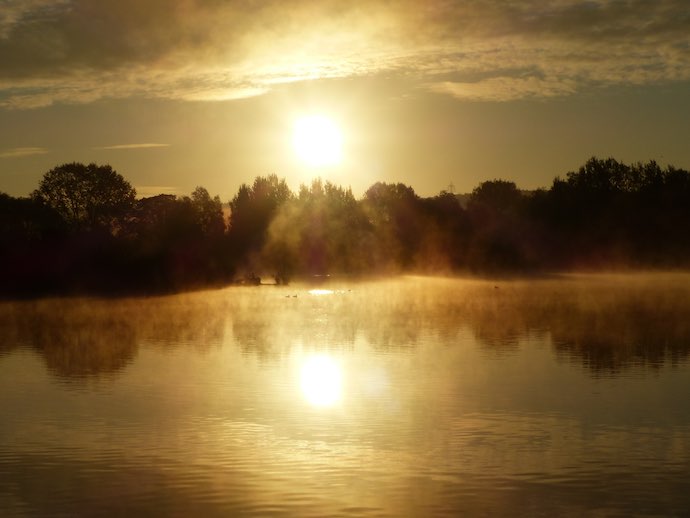
Why American signal crayfish are such a disaster to river ecosystems
Our wetland ecosystems have now been invaded by the non-native American signal crayfish, amongst others. Research carried out by David Rogers, Professor of Freshwater Biology at the University of Derby, showed:
“They are a major threat to the ecosystems of our rivers, there is no doubt about that. On the Kennet we estimate there are millions of them and you would have to trap thousands of them every day not to eradicate them but simply to reduce their impact. They will eat plants, insects, fish, snails, detritus and even their own young. When they are in dense colonies you can actually see the river bank retreating as they burrow into it.”
Nothing short of an ecosystem disaster. And yet, who is helping to reduce the number of these invaders? Otters who can be seen preying on them in our rivers!
What use are otters and why do they matter?
Otters are part of the intricate, delicately balanced web of life. In Hans Kruuk’s Otters, Ecology, Behaviour and Conservation, p. 137 he says:
“There are leads emerging about the effects that otters exert on their prey, about the role that they play in aquatic ecosystems. There was evidence that in our study sites, in both sea and fresh water, Eurasian Otters accounted for a substantial proportion of the biomass and productivity of some of the prey species. In itself this does not imply an effect on prey populations and food levels further down the ecosystem, but the potential is there: it exposes a dire need for further research…”
This is highlighted by another species, the sea otter which can occur in much higher densities than other otters, including our Eurasian otter.
“This animal is part of a chain of profound perturbations in the coastal underwater environment of the Pacific, affecting entire forests of giant algae and enormous densities of urchins and molluscs.” (p. 137 *)
Alaska’s fish are thriving thanks to the presence and role of the beaver and otter in helping their wetland ecosystem to thrive. Clearly, both beavers and otters are an important part of the Alaskan ecosystem’s delicate, interconnected web. Just as they were in the UK until their disappearance. They are keystone species. We may not yet have the data which will show why they are so vital to our rivers and wetlands, but they undoubtedly are. When these keystone species are absent the whole ecosystem begins to imperceptibly and then noticeably collapse. Rivers are affected both by what you put into them, such as agri-chemicals, and the life-enabling wildlife community you might remove: either deliberately by culling, or by failing to provide habitat. This can be caused by practices such as farmers mowing or growing crops close to the edge of waterways, allowing cattle to trample them or communities gardening the banks of rivers alongside their homes. There is some great advice from the Sussex Wildlife Trust on how to best manage land for otters (document download).
I look forward to the day when beavers are a common sight on our rivers once more, creating more wetland habitat for other wildlife like birds, fish, insects, amphibians and other mammals such as water voles. Whilst beavers create fish spawning backwaters and ponds, the otter’s presence clearly has a beneficial effect which needs to be fully understood. Both are vital riverine species for healthy fish populations.
Do send your pictures of wildlife to us on our Twitter or Facebook sites. We love to see them!
*Hans Kruuk – Otters: Ecology, Behaviour and Conservation
Special thanks to James Common for his advice.

